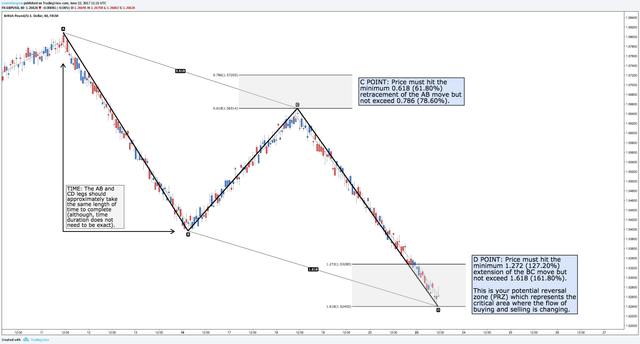
Hello traders, following up from my previous educational post I received several requests for my take on the AB=CD pattern.
This structure represents the basic foundation for all harmonic patterns, it is one of the classic chart patterns which is repeated over and over again.
It was developed by Scott M. Carney and Larry Pesavento after being originally discovered by H.M Gartley.
Firstly to spot this chart pattern like any other, you need to train the eye. It may be difficult at first but over-time it will become natural through repetition.

How do I measure the move?
Grab your fibonacci retracement tool and draw from point A to point B of the initial move or impulse leg to get point C. This must hit the minimum 0.618 (61.80%) retracement of the A to B move but not exceed 0.786 (78.60%).
A valid C point is illustrated on the chart with two horizontal lines and a grey box.
You're now looking to complete the pattern by locating the D point which is the potential reversal zone (PRZ), this represents a critical area where the flow of buying and selling is potentially changing. The D point is an extension of the A to B move that must hit the minimum 1.272 (127.20%) extension but not exceed 1.618 (161.80%).
A valid D point is illustrated on the chart with two horizontal lines and a grey box.
Or alternatively you can measure this move by using the ABCD pattern tool provided by TradingView.
To summarise, the measurements for a valid AB=CD pattern are detailed below.
C: 0.618 - 0.786
D: 1.272 - 1.618
The measurements for a perfect AB=CD pattern are detailed below.
C: 0.618
D: 1.618
Trading Rules
Wait until the pattern fully completes at the D point before buying or selling.
Here are a few tips on finding a pattern with a higher probability rate (although not essential for a valid pattern):
- The length of line AB should be equal to the length of line CD.
- The time it takes for the price to move from A to B should be equal to the time it takes for the price to move from C to D.
Stop Loss
When looking to place your stops there are many ways this can be done depending on your trading plan, but it should always be placed below the D point.
Your risk to reward ratio should be a minimum of 1:2 on every trade, if this cannot be achieved then I would not personally take the trade.
Take Profit
When using take profit targets I highly recommend having two and not just one, meaning you can close the trade after your first target has been reached or move your stop loss into profit (risk free trade).
Just like your stop loss there are many ways this can be done depending on your trading plan, but I recommend setting your take profit levels at the highs or lows of C & A.
Timeframes & Currency Pairs
This pattern like any other and is more profitable with certain currency pairs and timeframes, you should do your own back testing before trading the pattern.
Personally speaking this pattern holds and better structure and performs best on higher timeframes such as the 4h and daily rather than the 5m.
To Round Off
I truly hope this post explained how to trade the AB=CD pattern.
This post received a 3.4% upvote from @randowhale thanks to @lewisglasgow! For more information, click here!
Downvoting a post can decrease pending rewards and make it less visible. Common reasons:
Submit
Hey Lewis, great post!!
Thanks for the information!
Downvoting a post can decrease pending rewards and make it less visible. Common reasons:
Submit
Thank you! Enjoy your weekend when it comes man :)
Downvoting a post can decrease pending rewards and make it less visible. Common reasons:
Submit